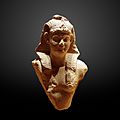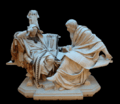Nero facts for kids
Quick facts for kids Nero |
|||||
|---|---|---|---|---|---|
| Emperor of the Roman Empire | |||||
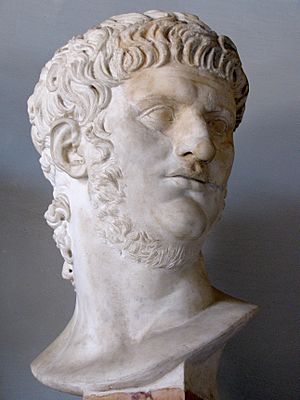
Bust of Nero
|
|||||
| Reign | 13 October, AD 54 – 9 June, AD 68 | ||||
| Predecessor | Claudius | ||||
| Successor | Servius Sulpicius Galba | ||||
| Born | 15 December 37 Antium |
||||
| Died | 9 June 68 (aged 30) Outside Rome |
||||
| Burial | Mausoleum of the Domitii Ahenobarbi, Pincian Hill, Rome | ||||
| Wives |
|
||||
| Issue | Claudia Augusta | ||||
|
|||||
| Dynasty | Julio-Claudian | ||||
| Father | Gnaeus Domitius Ahenobarbus | ||||
| Mother | Agrippina the Younger | ||||
Nero (Nerō Claudius Caesar Augustus Germanicus; 15 December 37 AD – 9 June 68 AD) was the fifth and last Roman Emperor of the Julio-Claudian dynasty.
Contents
Early life
Nero was born Lucius Domitius Ahenobarbus on 15 December AD 37 in Antium (modern Anzio). He was an only-child, the son of the politician Gnaeus Domitius Ahenobarbus and Agrippina the Younger. His mother Agrippina was the sister of the third Roman emperor Caligula.
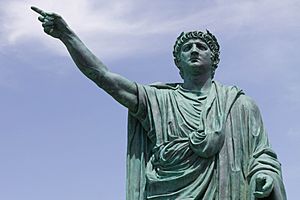
After Caligula's death, Claudius became the new emperor. Nero's mother married Claudius in AD 49, becoming his fourth wife. On 25 February AD 50, Claudius was pressured to adopt Nero as his son, giving him the new name of "Nero Claudius Caesar Drusus Germanicus". Claudius had gold coins issued to mark the adoption.
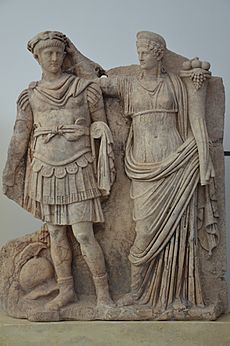
Nero formally entered public life as an adult in AD 51 at 14 years old. When he turned 16, Nero married Claudius' daughter (his step-sister), Claudia Octavia.
Claudius died in AD 54; many ancient historians claim that he was poisoned by Agrippina, so that Nero could assume power.
Reign (AD 54–68)
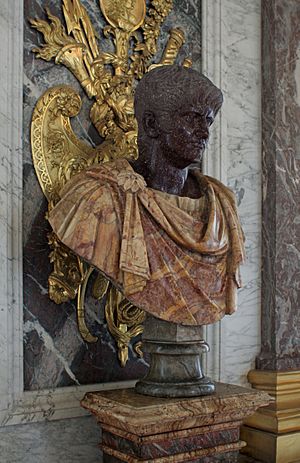
In the early years of his reign, Nero was advised and guided by his mother Agrippina, his tutor Seneca the Younger, and his praetorian prefect Sextus Afranius Burrus, but soon sought to rule independently.
Nero's practical contributions to Rome's governance focused on diplomacy, trade, and culture. He ordered the construction of amphitheaters, and promoted athletic games and contests. He made public appearances as an actor, poet, musician, and charioteer. The provision of such entertainments made Nero popular among lower-class citizens, but his performances undermined the Imperial dignity.
During Nero's reign, the general Corbulo fought the Roman–Parthian War of 58–63, and made peace with the hostile Parthian Empire. The Roman general Suetonius Paulinus quashed a major revolt in Britain led by queen Boudica. The Bosporan Kingdom was briefly annexed to the empire, and the First Jewish–Roman War began.
Most Roman sources offer overwhelmingly negative assessments of his personality and reign. Most contemporary sources describe him as tyrannical and self-indulgent. Some modern historians, however, question the reliability of ancient sources on Nero's tyrannical reign, considering his popularity among the Roman commoners.
Great Fire of Rome
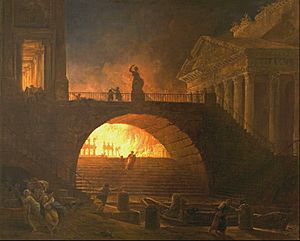
The Great Fire of Rome began on the night of 18 to 19 July 64. Rome had always been vulnerable to fires, and this one was fanned to catastrophic proportions by the winds. The fire burned for over seven days before subsiding; it then started again and burned for three more. It destroyed three of Rome's 14 districts and severely damaged seven more.
Some Romans thought the fire an accident. Others claimed it was arson committed on Nero's behalf. However, some historians suspend judgment on Nero's responsibility for the fire as he was in Antium when the fire started, and returned to Rome to organize a relief effort, which he paid for from his own funds. After the fire, Nero opened his palaces to provide shelter for the homeless, and arranged for food supplies to be delivered in order to prevent starvation among the survivors.
To remove suspicion from himself, Nero accused Christians of starting the fire. Many Christians were arrested and brutally executed.
Houses built after the fire were spaced out, built in brick, and faced by porticos on wide roads. Nero also built himself a new palace complex known as the Domus Aurea in an area cleared by the fire. The cost to rebuild Rome was immense, requiring funds the state treasury did not have. To find the necessary funds for the reconstruction, Nero's government increased taxation. Particularly heavy tributes were imposed on the provinces of the empire. To meet at least a portion of the costs, Nero devalued the Roman currency, increasing inflationary pressure for the first time in the Empire's history.
Revolt of Vindex and Galba
In March 68, Gaius Julius Vindex, the governor of Gallia Lugdunensis, rebelled against Nero's tax policies. Lucius Verginius Rufus, the governor of Germania Superior, was ordered to put down Vindex's rebellion. In an attempt to gain support from outside his own province, Vindex called upon Servius Sulpicius Galba, the governor of Hispania Tarraconensis, to join the rebellion and to declare himself emperor in opposition to Nero.

At the Battle of Vesontio in May 68, Verginius' forces easily defeated those of Vindex. However, after defeating the rebel, Verginius' legions attempted to proclaim their own commander as Emperor.
While Nero had retained some control of the situation, support for Galba increased.
Nero fled Rome with the intention of going to the port of Ostia and, from there, to take a fleet to one of the still-loyal eastern provinces. According to Suetonius, Nero abandoned the idea when some army officers openly refused to obey his commands.
Nero returned to Rome and spent the evening in the palace. After sleeping, he awoke at about midnight to find the palace guard had left. Dispatching messages to his friends' palace chambers for them to come, he received no answers. Upon going to their chambers personally, he found them all abandoned. When he called for a gladiator or anyone else adept with a sword to kill him, no one appeared. He cried, "Have I neither friend nor foe?" and ran out as if to throw himself into the Tiber.
Returning, Nero sought a place where he could hide and collect his thoughts. An imperial freedman, Phaon, offered his villa, located 4 mi (6.4 km) outside the city. Travelling in disguise, Nero and four loyal freedmen reached the villa, where Nero ordered them to dig a grave for him. At this time, Nero learned that the Senate had declared him a public enemy.
Death
Losing his nerve, Nero begged his private secretary, Epaphroditus, to kill him. Nero's final words were "Too late! This is fidelity!". He died on 9 June 68, the anniversary of the death of his first wife, Claudia Octavia, and was buried in the Mausoleum of the Domitii Ahenobarbi, in what is now the Villa Borghese (Pincian Hill) area of Rome.
With his death, the Julio-Claudian dynasty ended. Chaos would ensue in the year of the Four Emperors.
Images for kids
-
An aureus of Nero and his mother, c. 54. Caption: NERONIS CAES MATER AGRIPP. AVG. DIVI CLAVD. / NERONI CLAVD. DIVI F. CAES. AVG. GERM. IMP. TR. P. – EX SC
-
Emperor Nero being instructed by Seneca, work by Spanish sculptor Eduardo Barrón
-
The Fire of Rome by Hubert Robert (1785)
-
A circa 18th century woodcut of the historian Josephus (c. 37–100) who accused other historians of slandering Nero.
See also
 In Spanish: Nerón para niños
In Spanish: Nerón para niños




